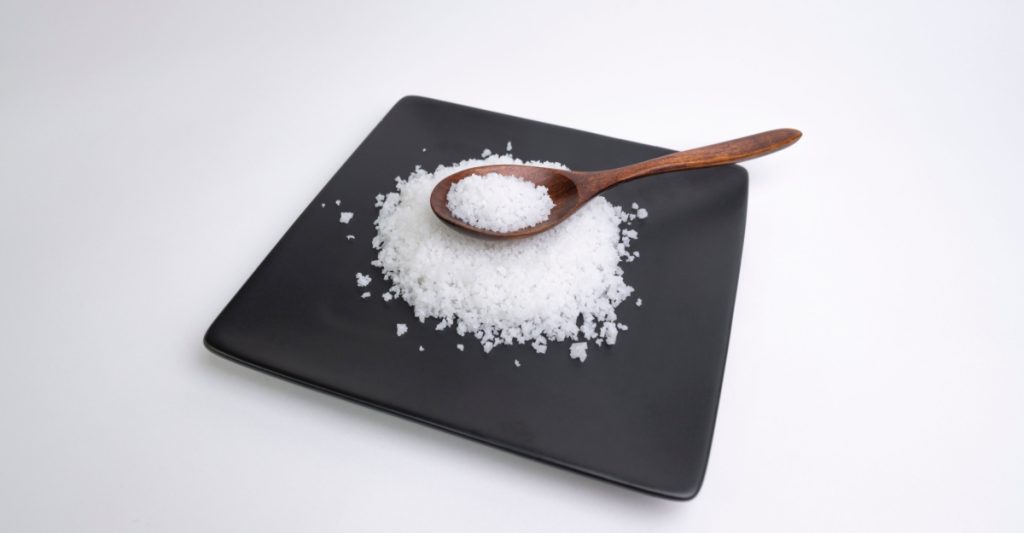About 1.3 billion people in the world live with high blood pressure, but only less than 260 million of them have their blood pressure (BP) under control. Following special dietary guidelines is one of the first steps toward controlling your blood pressure.
Most important is your sodium intake. Too much salt in your diet can raise blood pressure beyond normal. The average person’s sodium intake is one thing, but how much sodium per day should people with hypertension consume?
Fortunately, this guide will answer that question for you. Let’s talk about sodium intake and high blood pressure.

Master your heart health now
Take part in our 60sec quiz and get a heart health plan tailored just for you.
Contents
Understanding High Blood Pressure and Sodium
High blood pressure is when your blood exerts too much force on the walls of your arteries. This corresponds to a BP over 130/80mmHg.
Over time, this high pressure can damage blood vessels throughout the body, including the coronary arteries that feed the heart, causing heart disease.
Meanwhile, sodium is a mineral that the body uses for fluid balance and proper functioning of the muscles and nerves.
The problem is sodium pulls water in toward itself (which is how it helps with fluid balance). When there’s too much sodium in your blood, it attracts water, which increases your blood volume, and this will raise blood pressure.
Start managing your heart health now!
Find out what works for you with this 60sec quiz.

Recommended Daily Sodium Intake for High Blood Pressure

For anyone over the age of 14, the Dietary Guidelines for Americans recommend 2,300mg of sodium daily. However, if you have hypertension, when you reduce sodium intake below this, it can help you lower your blood pressure.
The American Heart Association recommends that individuals with high blood pressure aim to drop their salt intake to below 1,500mg daily.
However, before you drop your sodium intake as low as you can, make sure to talk to a healthcare professional to get a recommendation specific to you. If you exercise a lot or work in a hot environment, you’ll sweat more, and this sometimes calls for a higher salt intake.
The Impact of Excessive Sodium Consumption on Blood Pressure
As mentioned earlier, when you consume too much salt, and it gets into your bloodstream, it retains water in the vessels. The resulting increase in blood volume can lead to an increase in blood pressure.
If you have hypertension and continue on a high-salt diet, you may not only worsen the condition but make any medication or lifestyle modifications less effective. It can also increase the risk of medical conditions like heart failure, stroke, and kidney disease.
The Positive Impact of Sodium Control on Blood Pressure
With high blood pressure, a low-sodium diet can be an effective option. Several studies have been able to show that lower salt intake results in lower blood pressure. One of these showed that the higher the initial BP, the greater the effect of less salt.
Another study was able to show that the Dietary Approaches to Stop Hypertension, or the DASH diet, in combination with reduced salt intake, could lower high blood pressure by as much as 20mmHg.
Reducing your dietary sodium can not only lower high blood pressure but it can reduce the risk of complications like stroke, heart attack, and heart disease. Even without hypertension, you can live a better life when you reduce salt in your diet.
Tips for Reducing Salt Intake for People With High Blood Pressure

On average, Americans consume more than 3,400mg of sodium every day, according to the Centers for Disease Control and Prevention.
That is a lot of salt, and most of it comes from the many foods that people are used to. This can make reducing sodium hard, but with the right tips, you can get it done.
Get to know the common courses of sodium
Before you can go on a low-salt diet, you need to know where most of your sodium comes from.
Table salt, or sodium chloride, is the primary form of sodium in the human diet. However, most of the sodium we eat doesn’t come from our salt shaker – it’s from the processed foods that we buy. In fact, about 70% of the sodium content in the diet comes from these processed foods.
Many foods you buy off the shelf or prepared foods from a restaurant are high in sodium. Knowing these foods before you buy them can be an important step in reducing sodium in your diet.
Here are some of the foods that you should cut down on or avoid entirely:
- Cured and processed meats like hot dogs, cold cuts, and ham
- Bread and rolls
- Snacks like potato chips, popcorn, and crackers
- Cheese
- Canned foods like soups and some canned vegetables
- Fast food like pizza, burgers, and fried chicken
- Condiments like soy sauce, salad dressings, ketchup, and mustard
- High-sodium seasonings like onion, celery, or garlic salts
Start managing your heart health now!
Find out what works for you with this 60sec quiz.

Read food labels to understand sodium information
The “Nutrition Facts” label that comes on most packaged food at grocery stores can have tons of information on how healthy what you’re about to eat is. In this case, it is useful because it will show you the amount of sodium that you’re about to eat.
The first thing you need to do when you look at this food label is see the size of one serving, which you can find at the top. This is important because all the other values on the label, including sodium content, are in reference to a single serving.
Look down toward the “Sodium” entry here. You’ll see the amount of sodium each serving has in milligrams.
You’ll also see a percentage on the right side. This shows what portion of your recommended 2,300mg of sodium is covered by a single serving of the food. Note that anything over 20% is considered to be high in sodium, and under 5% is low.
When you’re grocery shopping, especially when buying canned foods, aim for the ones that have “no salt added” or “low sodium” labeling. Avoid foods that have more than 20% of your daily value of sodium in a single serving too.
Choose healthy alternatives
A lot of the processed foods that we’re used to have added salt, so it can be hard weaning yourself off of them. The good thing is that there are some alternatives you can turn to that make things easier.
- A lot of condiments have variants with less salt in them. This includes salad dressings, ketchup, and so on.
- When cooking, opt for salt substitutes instead of table salt. Many of these are high in potassium, and a high-potassium diet can be very helpful in lowering blood pressure.
- Instead of adding salt, be generous with seasonings. You can use garlic, ginger, onions, pepper, vinegar, lemon juice, and herbs and spices.
- Opt for low-salt versions of your favorite snacks and foods. For instance, go for unsalted nuts, low-salt crackers, plain popcorn, and others.
- Go for fresh lean meats instead of cold cuts and meats that have been processed or cured.
Stay hydrated to maintain your fluid balance
Maintaining normal blood pressure arises majorly as part of a balance between the water in your body and minerals like sodium and potassium. When your body retains fluid in the blood vessels, it causes increased BP.
When you’re dehydrated, it might seem like since there’s less water in your body, your blood pressure drops, but that’s not the case. Being dehydrated does reduce your blood volume, but it also concentrates the sodium that’s left over.
This concentration stimulates the release of vasopressin, and this hormone also increases blood pressure by making your vessels constrict.
Simply making sure that you stay well hydrated can maintain normal fluid balance and keep your BP under control.
Follow a healthy lifestyle
Reducing the salt in the foods you eat can eliminate one risk factor of high blood pressure, but there are other healthy lifestyle changes you can make to make managing your blood pressure even easier.
- Regular exercise: Doing at least 150 minutes of moderate physical activity every week can really help keep your blood pressure in control.
- Healthy balanced diet: Besides reducing the amount of salt you eat, you can generally avoid highly processed foods high in saturated fat and added sugar. Also, incorporate more fresh vegetables and fruits, whole grains, and unsaturated fat.
- Effective stress management: Stress can increase your blood pressure. Tap into techniques that can help you keep your stress at bay.
- Good sleep: Not sleeping enough can keep your BP elevated. Make sure to get adequate sleep every night to avoid pushing your BP up.
Cardi Health can make living with high blood pressure easier. It can help you put together a personalized meal plan that is healthy and also has foods that your taste buds enjoy, and a unique exercise plan, to keep you active and your body weight down.
Start managing your heart health now!
Find out what works for you with this 60sec quiz.

Final Considerations
The amount of salt in the foods you eat can have a big impact on your blood pressure. The average person should have less than 2,300mg, but people with hypertension should aim to keep their salt intake under 1,500mg daily.
You can reduce salt intake by being vigilant when eating already prepared foods and processed foods and replacing them with healthier variants.
However, everyone is different, so make sure to reach out to your healthcare professional to get medical advice that works for you.
Related articles
Best Foods to Lower Cholesterol
Does Caffeine Raise Blood Pressure?
Does Drinking Water Lower Blood Pressure?
Causes of High Blood Pressure at Night
10 DASH Diet Breakfasts for a Healthy Start
Heart-Healthy Diet Guide
What Should an 85-Year-Old Blood Pressure Be?
What is Normal Blood Pressure for a 70-Year-Old?
How to Read Blood Pressure: A Comprehensive Guide
Manage your heart health now
Find out what works best for you with this 60sec quiz and get your personalized heart health plan.

